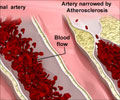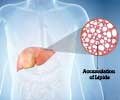During the study of anti atherosclerosis therapies a tendancy towards development of a dangerous blood cancer known as chronic myelogenous leukemia, or CML was found.
Scientists studying inflammation and atherosclerosis have recently seen a convergence of their respective fields. Another recent discovery made during the study of anti atherosclerosis therapies was a tendancy towards development of a dangerous blood cancer known as hronic myelogenous leukemia, or CML.
Inflammation is an aspect of the immune response to injury and disease; atherosclerosis, with its characteristic lesions in the blood vessel walls, underlies most cardiovascular disease, including heart attacks and strokes.Scientists at The Wistar Institute pursuing a promising new immune-system target for anti-atherosclerosis therapies discovered an unwanted potential side effect of any such therapies is a dangerous blood cancer called chronic myelogenous leukemia, or CML. More positively, the CML seen in the genetic strain of mice used in the study closely mimics human CML, so that the mice offer a new model for studying CML, opening the door for researchers to better understand that disease. The Wistar team's results are featured on the cover of the current issue of the Journal of Experimental Medicine, published October 30.
The Wistar scientists initiated their experiments to build on a series of findings that had suggested that blocking certain enzymes called lipoxygenases could inhibit the kind of chronic inflammation in the blood vessel walls that drives the atherosclerotic process. Even better, blocking these enzymes seemed only to affect one type of immune cell, the macrophage, and to interfere only with its role in chronic inflammation. The acute response of the macrophages to infectious agents like bacteria, critical for protection against disease, remained unfettered.
"We and others had hoped that blocking this enzyme would safely slow or stop certain chronic inflammatory responses that have been linked to atherosclerosis," says Ellen Puré, Ph.D., a professor in the Molecular and Cellular Oncogenesis and Immunology programs at Wistar and senior author on the study. "Now we know that if we go that route, we may also unwittingly be promoting leukemia."
To better understand the details of this inflammatory process as it unfolds in atherosclerosis, the Wistar researchers worked with a strain of experimental mice lacking the gene for a specific pivotal lipoxygenase enzyme. They then crossed these mice with other strains of mice genetically prone to atherosclerosis. Would the resulting mice without the lipoxygenase enzyme be protected from developing atherosclerosis, or would their genetic susceptibility to atherosclerosis win out? Either way, precisely what mechanisms were at work in the vessel walls?
Focused as they were on the atherosclerotic process in the blood vessel walls, the researchers nearly overlooked a significant change taking place in another part of the body: To their surprise, they noticed that the spleens of the mice lacking lipoxygenase became enlarged, dramatically so in some cases. In 15 percent of the mice, the spleens grew 5 to 10 times their normal size at the end of a year.
Advertisement
Exploring their observation, the scientists ascertained that the spleens of all of the mice in the experiments were somewhat enlarged, swollen with cells called granulocytes and macrophages, members of a family of immune cells called myeloid cells. The majority of mice were seen to have myeloid proliferative disease, a precursor to CML. And 15 percent of the mice had full-blown leukemias.
Advertisement
The silver lining in the situation, Puré says, is that the strain of mice used in their study may be the best model for human CML yet found. The subset of the mice with myeloid proliferative disease closely mimic the asymptomatic early stages of CML, while the 15 percent with clear CML model the crisis, or "blast," stage of the disease.
Source-Eurekalert
NLA











